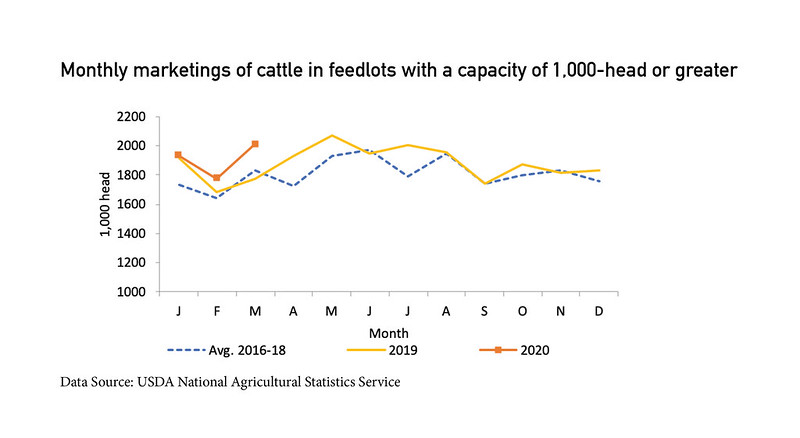April 29, 2020
Panic-buying causes surge in cattle marketing, but feedlot placements drop
By Mary Hightower
U of A System Division of Agriculture
Fast facts
- March cattle marketing rises on panic buying
- Feedlot placements shrink
- Slowdowns in processing may weigh down prices
(316 words)
(Newsrooms: with additional charts at https://flic.kr/s/aHsmMSB1aM)
(Download this story in MS Word format here.)
FAYETTEVILLE, Ark. — COVID-19-fueled panic buying prompted a sharp rise in fed cattle marketing, but feedlot placements have slowed in parallel to meat processing, according to an economic impact report from the University of Arkansas System Division of Agriculture.
John Anderson, head of the agricultural economics and agribusiness department for the Division of Agriculture and the Dale Bumpers College of Agriculture, Food and Life Sciences, provided an analysis based on the U.S. Department of Agriculture’s “Cattle on Feed” report.
In March, fed cattle marketing was “13 percent higher than the prior year,” he said. “This was the second-highest marketing figure for March since this Cattle on Feed series began in 1996.”
Anderson said the quick pace of marketing noted in the report “confirms the fact that meat packers in March were operating at a very high capacity in an effort to match the surge in demand caused by panic buying.”
While the number of cattle marketed from feedlots increased, the number of cattle being placed into feedlots for finishing fell sharply. As a result, the number of cattle in feedlots as of April 1 dropped slightly more than 5 percent from the prior year.
“The decline in feedlot inventories is strongly counter-seasonal,” he said. “Typically, on-feed inventories rise from March to April as feeder cattle come out of winter grazing.”
Anderson said he expects the number of cattle being marketed “will be much lower as a result of plant closings and slowdowns in response to COVID-19.”
He noted that cattle processed for meat the week of April 21 dropped 25 percent from the previous year’s level.
“With such a dramatic reduction in throughput, inventories of market-ready cattle will rapidly increase,” he said. “This will intensify negative pressure on cattle prices at all levels.”
To learn more about agricultural economics, contact your local county extension agent or visit www.uaex.uada.edu. Follow us on Twitter at @AR_Extension.
About the Division of Agriculture
The University of Arkansas System Division of Agriculture’s mission is to strengthen agriculture, communities, and families by connecting trusted research to the adoption of best practices. Through the Agricultural Experiment Station and the Cooperative Extension Service, the Division of Agriculture conducts research and extension work within the nation’s historic land grant education system.
The Division of Agriculture is one of 20 entities within the University of Arkansas System. It has offices in all 75 counties in Arkansas and faculty on five system campuses.
Pursuant to 7 CFR § 15.3, the University of Arkansas System Division of Agriculture offers all its Extension and Research programs and services (including employment) without regard to race, color, sex, national origin, religion, age, disability, marital or veteran status, genetic information, sexual preference, pregnancy or any other legally protected status, and is an equal opportunity institution.
# # #
Media Contact: Mary Hightower
Director of Communications
University of Arkansas System Division of Agriculture
mhightower@uada.edu
501-671-2006
